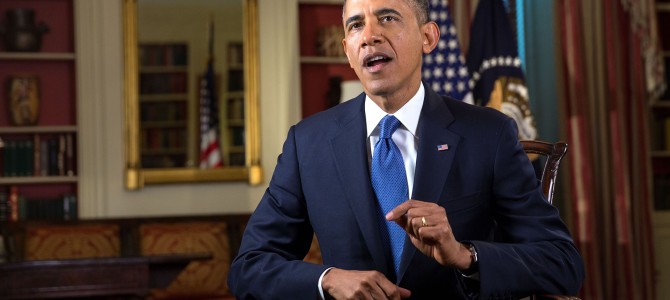
As an advocate of limited government—very limited—I am used to being peppered with questions about what we would do if the government stopped funding one of the various human activities that people regard as traditional objects of federal largesse. The implication is that nothing can survive without government support, so if you don’t want the government to fund one of these things—symphonies, museums, libraries, parks, and on and on—then you must be opposed to its very existence.
This idea was summed up in a political cartoon I remember seeing in the 1990s which showed Newt Gingrich taking an axe to Michelangelo’s David. Because, you see, he wanted to cut funding to the National Endowment for the Arts. The message was preposterously crude, and the most ridiculous part was the choice of artistic example. If you’ve ever seen anything funded by the National Endowment for the Arts—well, let’s just say that it ain’t exactly the David.
In a similar vein, I’ve often been asked: if government doesn’t fund scientific research, who will? This has always been posed as a rhetorical question, a kind of utopian thought experiment, because of course government was going to keep dominating scientific research.
Except that it is no longer purely theoretical, and we’re now starting to get our answer. And this brave experiment in laissez faire is being conducted under the Obama administration.
The New York Times recently published a long report by William Broad on the rise—I would say, the resurrection—of private funding for scientific research.
American science, long a source of national power and pride, is increasingly becoming a private enterprise.
In Washington, budget cuts have left the nation’s research complex reeling. Labs are closing. Scientists are being laid off. Projects are being put on the shelf, especially in the risky, freewheeling realm of basic research. Yet from Silicon Valley to Wall Street, science philanthropy is hot, as many of the richest Americans seek to reinvent themselves as patrons of social progress through science research.
This conclusion is a bit overstated. The federal government still spends tens of billions of dollars on scientific research, so the field is hardly “privatized.” More important, private support for science is hardly new. For such a long article, the Times devotes not a single paragraph to describing what things were like before government got into the business of funding science, back when most scientific research and expeditions—along with the libraries and universities and museums—were funded by private donors. The magnificent Carnegie Museum of Natural History in Pittsburgh, for example, was founded by the steel tycoon Andrew Carnegie and stocked with fossils unearthed by expeditions he funded. So today’s big scientific patrons are merely continuing a long and venerable tradition.
Moreover, there is a lot of evidence that they are getting better results, with less money, than the government does.
They have mounted a private war on disease, with new protocols that break down walls between academia and industry to turn basic discoveries into effective treatments. They have rekindled traditions of scientific exploration by financing hunts for dinosaur bones and giant sea creatures. They are even beginning to challenge Washington in the costly game of big science, with innovative ships, undersea craft and giant telescopes—as well as the first private mission to deep space.
Some of the benefit is the entrepreneurial spirit and management skills brought to science by donors who come up through world of business rather than the bureaucracy. One academic describes how private donors overcame his initial skepticism.
What changed his mind, he said, was watching them persevere, year after year, in pursuit of highly ambitious goals. “They target polio and go after it until it’s done—no one else can do that,” he said, referring to the global drive to eradicate the disease. “In effect, they have the power to lead where the market and the political will are insufficient.”
Similarly, a private space mission described in the article is projected to cost about half of what NASA would spend. (Or maybe they should outsource it. As one wag observed, India just spent less money to send a probe to Mars than Alfonso Cuaron spent to make a movie about a space mission.)
The downside of private patrons is mostly what you would expect: dilettantes funding vanity projects with little scientific value. So the New York Times piece frets about private patrons “ignoring basic research” in favor of projects in “a jumble of popular, feel-good fields like environmental studies and space exploration.” The science journal Nature editorializes that private funding could “skew” research.
Of course, we know that this could never happen with government. A respected scientific agency like, say, NASA, would never start producing dubious mathematical models to bolster its masters’ latest political rhetoric on an issue totally unrelated to NASA’s mission like, say, income inequality. Oh, wait.
As usual with this sort of story, evidence that private funding can take the place of government funding has to be coupled with strenuous declarations that this could never actually happen. But then again, “the government knows very little about how much philanthropic money is flowing into science, or how it is being spent.” You would think people interested in science would gather some data first before pronouncing a verdict on a subject they “know very little about.”
Ah, but a few sentences later, we are told that “the issues are considered social as well as intellectual,” and that government grants “consider gender and race, income and geography.” Geography? Translation: sending pork barrel spending to the home districts of congressmen. No wonder everything costs twice as much when the government does it.
But the big omission in this article is why all of this is happening, why government research is fading so that private funding has to surge to take up the slack. There is a general implication that the cuts are caused by those mean Republicans. But House Republicans are just the messengers.
What’s really happening is that the welfare state is crowding out everything else the government does. Entitlement programs can’t be reined in—not without a major new piece of legislation—because their benefits are set by previous statutes and are therefore considered “mandatory” spending. The defense budget is also politically difficult to cut. After the past few weeks’ events in Ukraine, such cuts are also looking unwise; this is, after all, spending that really is mandatory in the actual sense of being mandated by the Constitution. So the only cuts that can be made to the federal budget are to “non-defense discretionary spending,” an ever-shrinking portion of the federal budget. In 2010, this was about 15% of federal spending, as opposed to 60% for the big entitlement programs—a number that is scheduled to grow precipitously as the Baby Boomers retire and become old and decrepit.
If “non-defense discretionary spending” is what gets squeezed to make room for entitlements, this implies that we’re likely to get a few more of these laissez-faire experiments, as the government simply runs out of money for its various worthwhile aspirations.
This, in turn, will endanger the welfare state.
After all, what was the point of all those questions about how we can fund science, or education, or roads, and so on, without government? The point was to take things that are indisputably productive and valuable—science, education, transportation—and use the vital necessity of these goods to make the case for government in general. The point was not to have to argue directly for the wisdom and morality of robbing Peter to pay Paul, but to be able to vilify any advocate of laissez-faire by saying he’s an enemy of science and education and roads.
But what if the federal government does less and less of these things, as the increasing cost of the welfare state will require it to do? What if we get more demonstrations of how science and art and roads and—we can always hope—education can thrive with private funding? Then the only remaining “essential” role for government is that it’s the only institution that can rob Peter to pay Paul. All the statists will be left with is defending welfare as such.
They will go from “government is the name we give to the things we choose to do together,” to “government is the name for taking your money and giving it to somebody else.” Which is a much less appealing description.
Follow Robert on Twitter.









